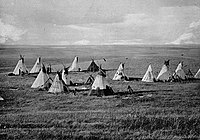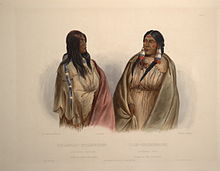Cree: Difference between revisions
No edit summary |
m Reverted 1 edit by 208.38.37.158 identified as vandalism to last revision by 24.72.46.139. |
||
| Line 12: | Line 12: | ||
|related=[[Métis]], [[Oji-Cree]], [[Ojibwe]] |
|related=[[Métis]], [[Oji-Cree]], [[Ojibwe]] |
||
}} |
}} |
||
'''Cree''' is a misnomer {{Dubious|date=March 2008}} applied to various peoples indigenous to North America, namely the Nehiyaw, Nehithaw, Nehilaw, Nehinaw, Ininiw, Ililiw, [[Iynu]], and Iyyu. These peoples can be divided into two major groups, those that identify themselves using a derivative of their historical appellation [[Nehilâw]] and those identifying themselves using the word "person", historically [[Iliniw]].{{Fact|date=March 2008}} Both groups share a common ancestry but are now divided mainly along linguistic lines. Those residing west of the [[Ontario]] border (except for one group residing in [[Quebec]] mistakingly called [[Attikamek]] but who self-identify as [[Nehiraw]]) all the way to the [[Rocky Mountains]] tend to refer to themselves using the first name, historically "Nehilaw". The second group includes all the groups east of [[James Bay]] use the historical term for man "Iliniw" are were mistakingly called Montagnais and Naskapi as well as Cree. {{Fact|date=March 2008}} |
|||
'''Cree''' is a misnomer {{Dubious|date=March 2008}} applied to various peoples indigenous to North America, namely the |
|||
Both major groups speak languages of the [[Algonquin language]] family. There is a major division between both groups however, in that the Eastern group [[palatalizes]] the sound /k/ when it precedes [[front vowels]]. There is also a major difference in grammatical vocabulary (particles) between the groups. Within both groups however, there is variation around the pronunciation of the [[Proto-Algonquian]] [[phoneme]] *l, which can be realized as /l/, /r/, /y/, /n/, or /th/ by different groups. |
|||
The rest of the article will focus on the western group, the group usually referred to when the misnomer 'Cree' is used.{{Fact|date=March 2008}} |
|||
Skilled [[American bison|buffalo]] hunters and horsemen, the Cree were allied to the [[Assiniboine]] of the [[Sioux]] before encountering English, Scottish (especially Orcadian) and French settlers in the [[16th century]]. |
|||
Presently, the remaining Cree in the United States live on the [[Rocky Boy Indian Reservation]] which is shared with the [[Ojibwa|Chippewa]]. |
|||
== In Canada == |
|||
[[Image:Edward S. Curtis Collection People 095.jpg|thumb|Nehiyaw Girl (1928).]] |
|||
The Cree are the largest group of [[First Nations]] in Canada, with over 200,000 members and 135 registered bands.<ref name ="cangeo">[http://www.canadiangeographic.ca/magazine/ND05/indepth/justthefacts.asp Source:] [[Canadian Geographic]]</ref> This large number may be due to the Cree's traditional openness to inter-tribal marriage. Together, their reserve lands are the largest of any First Nations group in the country.<ref name ="cangeo"/> The largest Cree band and the second largest First Nations Band in Canada after the [[Six Nations]] [[Iroquois]] is the [[Lac La Ronge Band]] in northern [[Saskatchewan]]. |
|||
The [[Métis people (Canada)|Métis]] (from French Métis - any person of mixed ancestry.) are people of mixed ancestry such as Nehiyaw (or Anishinabe) and [[French people|French]], [[English people|English]], or [[Scottish people|Scottish]] heritage. According to the Canadian Government's Indian and Northern Affairs, the [[Metis]] were historically the children of French fur traders and Nehiyaw women or, from unions of English or Scottish traders and Northern [[Dene]] women. It is now generally accepted though in academic circles that the term [[Métis]] can be used to refer to any combination of persons of mixed Native American and European heritage. Although, historical definitions for [[Metis]] remain. Some [[Anglo-Metis]] are also of Cree descent. Canada's Indian and Northern Affairs specifically but broadly define [[Metis]] to be those persons of mixed First Nation and European ancestry. |
|||
==Cree First Nations== |
|||
[[Image:Woman of the Snake tribe and woman of the Cree tribe 0066v.jpg|thumb|A Nehiyaw woman (right)]] |
|||
*[[Barren Lands First Nation]] |
|||
*[[Beaver Lake Cree Nation]] |
|||
*[[Bigstone Cree Nation]] |
|||
*[[Chapleau Cree First Nation]] |
|||
*[[Enoch Cree Nation]] |
|||
*[[Fisher River Cree Nation]] |
|||
*[[James Smith First Nation]] |
|||
*[[Kashechewan First Nation]] |
|||
*[[Little Pine First Nation]] |
|||
*[[Little Red River Cree Nation]] |
|||
*[[Louis Bull Tribe First Nation]] |
|||
*[[Lubicon Lake Indian Nation]] |
|||
*[[Misipawistik Cree Nation]] |
|||
*[[Attawapiskat, Ontario|Mushkego James Bay Cree]] |
|||
*[[Muskoday First Nation]] |
|||
*[[Nisichawayasihk Cree Nation]] |
|||
*[[Norway House Cree Nation]] |
|||
*[[One Arrow First Nation]] |
|||
*[[Opaskwayak Cree Nation]] |
|||
*[[Saddle Lake Cree First Nation]] |
|||
*[[Sapotaweyak Cree Nation]] |
|||
*[[Sweetgrass First Nation]] |
|||
*[[Thunderchild First Nation]] |
|||
*[[Canoe Lake First Nation]] |
|||
==Notable Cree== |
|||
[[Image:Mähsette Kuiuab Chief of the Cree indians 0022v.jpg|thumb|Mähsette Kuiuab, chief of the Cree indians]] |
|||
*[[Irene Bedard]], actress |
|||
*[[Jonathan Cheechoo]], NHL hockey player |
|||
*[[Michael Greyeyes]], actor |
|||
*[[Autumn Petros-Good]], scientist |
|||
*[[Buffy Sainte-Marie]], singer |
|||
*[[Cree Summer]], singer/actress |
|||
*[[Gordon Tootoosis]], actor |
|||
*[[Shania Twain]], singer/songwriter born to a father of Cree background, adopted by [[Ojibwa]] step-father as a baby. |
|||
See: [[:Category:Cree people|Cree people]] |
|||
== See also == |
|||
{{Commons|Category:Cree}} |
|||
* [[James Bay Cree hydroelectric conflict]] |
|||
* [[Métis]] |
|||
* [[Michif]] |
|||
* [[Cree language]] |
|||
* [[Cree syllabics]] |
|||
* [[Politics of Saskatchewan]] |
|||
* [[Iynu]] |
|||
==References== |
|||
<references /> |
|||
Sacred Legends of the Sandy Lake Cree. James R. Stevens, McClelland and Stewart Ltd, 1971 |
|||
==External links== |
|||
*[http://www.creeculture.ca/e/index.html Cree cultural site] |
|||
*[http://www.gcc.ca/ Grand Council of the Crees (GCC) website] |
|||
*[http://www.schoolnet.ca/ABORIGINAL/Plains_Cree The Plains Cree - Ethnographic, Historical and Comparative Study by David Mandelbaum] |
|||
*[http://www.llrib.ca/home.php Lac La Ronge Band website] |
|||
*[http://lrrcn.ab.ca/ Little Red River Cree Nation website] |
|||
*[http://www.canadiangeographic.ca/magazine/nd05/indepth/history.asp Brief history of Cree] from [[Canadian Geographic]] |
|||
*{{cite book | author=Grant, Bruce | title=The Concise Encyclopedia of the American Indian | location=New York | publisher=Wings Books | year=2000 | id=ISBN 0-517-69310-0}} |
|||
*[http://archives.cbc.ca/IDD-1-69-94/life_society/james_bay/ CBC Digital Archives - James Bay Project and the Cree] |
|||
*[http://www.fisherriver.com/ Fisher River Cree Nation Official Website] |
|||
*[http://www.giftoflanguageandculture.ca/ The Gift of Language and Culture website] |
|||
*[http://cr.wikipedia.org/ Cree language Wikipedia] |
|||
[[Category:Cree| ]] |
|||
[[bs:Cree]] |
|||
[[ca:Cree]] |
|||
[[de:Cree]] |
|||
[[es:Cri]] |
|||
[[eo:Krioj]] |
|||
[[fr:Cris]] |
|||
[[hr:Cree]] |
|||
[[cr:Cree]] |
|||
[[pl:Kri]] |
|||
[[pt:Cree]] |
|||
[[ru:Кри (племя)]] |
|||
[[sh:Kri]] |
|||
[[fi:Creet]] |
|||
[[sv:Cree]] |
|||
[[uk:Крі]] |
|||
Revision as of 19:57, 1 April 2008
 Nehiyaw camp near Vermilion, Alberta | |
| Regions with significant populations | |
|---|---|
| Canada, United States | |
| Languages | |
| Cree, English, French | |
| Related ethnic groups | |
| Métis, Oji-Cree, Ojibwe |
Cree is a misnomer [dubious – discuss] applied to various peoples indigenous to North America, namely the Nehiyaw, Nehithaw, Nehilaw, Nehinaw, Ininiw, Ililiw, Iynu, and Iyyu. These peoples can be divided into two major groups, those that identify themselves using a derivative of their historical appellation Nehilâw and those identifying themselves using the word "person", historically Iliniw.[citation needed] Both groups share a common ancestry but are now divided mainly along linguistic lines. Those residing west of the Ontario border (except for one group residing in Quebec mistakingly called Attikamek but who self-identify as Nehiraw) all the way to the Rocky Mountains tend to refer to themselves using the first name, historically "Nehilaw". The second group includes all the groups east of James Bay use the historical term for man "Iliniw" are were mistakingly called Montagnais and Naskapi as well as Cree. [citation needed]
Both major groups speak languages of the Algonquin language family. There is a major division between both groups however, in that the Eastern group palatalizes the sound /k/ when it precedes front vowels. There is also a major difference in grammatical vocabulary (particles) between the groups. Within both groups however, there is variation around the pronunciation of the Proto-Algonquian phoneme *l, which can be realized as /l/, /r/, /y/, /n/, or /th/ by different groups.
The rest of the article will focus on the western group, the group usually referred to when the misnomer 'Cree' is used.[citation needed]
Skilled buffalo hunters and horsemen, the Cree were allied to the Assiniboine of the Sioux before encountering English, Scottish (especially Orcadian) and French settlers in the 16th century.
Presently, the remaining Cree in the United States live on the Rocky Boy Indian Reservation which is shared with the Chippewa.
In Canada

The Cree are the largest group of First Nations in Canada, with over 200,000 members and 135 registered bands.[1] This large number may be due to the Cree's traditional openness to inter-tribal marriage. Together, their reserve lands are the largest of any First Nations group in the country.[1] The largest Cree band and the second largest First Nations Band in Canada after the Six Nations Iroquois is the Lac La Ronge Band in northern Saskatchewan.
The Métis (from French Métis - any person of mixed ancestry.) are people of mixed ancestry such as Nehiyaw (or Anishinabe) and French, English, or Scottish heritage. According to the Canadian Government's Indian and Northern Affairs, the Metis were historically the children of French fur traders and Nehiyaw women or, from unions of English or Scottish traders and Northern Dene women. It is now generally accepted though in academic circles that the term Métis can be used to refer to any combination of persons of mixed Native American and European heritage. Although, historical definitions for Metis remain. Some Anglo-Metis are also of Cree descent. Canada's Indian and Northern Affairs specifically but broadly define Metis to be those persons of mixed First Nation and European ancestry.
Cree First Nations

- Barren Lands First Nation
- Beaver Lake Cree Nation
- Bigstone Cree Nation
- Chapleau Cree First Nation
- Enoch Cree Nation
- Fisher River Cree Nation
- James Smith First Nation
- Kashechewan First Nation
- Little Pine First Nation
- Little Red River Cree Nation
- Louis Bull Tribe First Nation
- Lubicon Lake Indian Nation
- Misipawistik Cree Nation
- Mushkego James Bay Cree
- Muskoday First Nation
- Nisichawayasihk Cree Nation
- Norway House Cree Nation
- One Arrow First Nation
- Opaskwayak Cree Nation
- Saddle Lake Cree First Nation
- Sapotaweyak Cree Nation
- Sweetgrass First Nation
- Thunderchild First Nation
- Canoe Lake First Nation
Notable Cree

- Irene Bedard, actress
- Jonathan Cheechoo, NHL hockey player
- Michael Greyeyes, actor
- Autumn Petros-Good, scientist
- Buffy Sainte-Marie, singer
- Cree Summer, singer/actress
- Gordon Tootoosis, actor
- Shania Twain, singer/songwriter born to a father of Cree background, adopted by Ojibwa step-father as a baby.
See: Cree people
See also
- James Bay Cree hydroelectric conflict
- Métis
- Michif
- Cree language
- Cree syllabics
- Politics of Saskatchewan
- Iynu
References
Sacred Legends of the Sandy Lake Cree. James R. Stevens, McClelland and Stewart Ltd, 1971
External links
- Cree cultural site
- Grand Council of the Crees (GCC) website
- The Plains Cree - Ethnographic, Historical and Comparative Study by David Mandelbaum
- Lac La Ronge Band website
- Little Red River Cree Nation website
- Brief history of Cree from Canadian Geographic
- Grant, Bruce (2000). The Concise Encyclopedia of the American Indian. New York: Wings Books. ISBN 0-517-69310-0.
- CBC Digital Archives - James Bay Project and the Cree
- Fisher River Cree Nation Official Website
- The Gift of Language and Culture website
- Cree language Wikipedia
